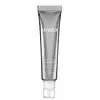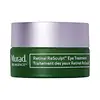What's inside
What's inside
 Key Ingredients
Key Ingredients

 Benefits
Benefits

 Concerns
Concerns

 Ingredients Side-by-side
Ingredients Side-by-side

Water
Skin ConditioningCaprylic/Capric Triglyceride
MaskingButyrospermum Parkii Butter
Skin ConditioningPropanediol
SolventArachidyl Alcohol
EmollientCetearyl Isononanoate
EmollientGlycerin
HumectantIsododecane
EmollientSqualane
EmollientEthylhexyl Palmitate
EmollientBehenyl Alcohol
EmollientCetearyl Alcohol
EmollientGlyceryl Stearate
EmollientMicrocrystalline Cellulose
AbsorbentPPG-12/Smdi Copolymer
EmollientTocopheryl Acetate
AntioxidantPhytosterols
Skin ConditioningPhenoxyethanol
PreservativeArachidyl Glucoside
EmulsifyingCyclodextrin
AbsorbentDimethicone
EmollientSodium Acrylates Copolymer
Tocopherol
AntioxidantLinoleic Acid
CleansingCeramide NP
Skin ConditioningBisabolol
MaskingHydroxyacetophenone
AntioxidantPandanus Conoideus Fruit Oil
EmollientSodium Stearoyl Glutamate
CleansingHelianthus Annuus Seed Oil
EmollientLecithin
EmollientCellulose
AbsorbentSodium Hyaluronate
HumectantRetinal
Skin ConditioningPentaerythrityl Tetra-Di-T-Butyl Hydroxyhydrocinnamate
AntioxidantLonicera Japonica Flower Extract
Skin ConditioningDaucus Carota Sativa Seed Oil
EmollientLonicera Caprifolium Flower Extract
PerfumingSodium Polyaspartate
HumectantXanthan Gum
EmulsifyingDisodium EDTA
Ethylhexylglycerin
Skin ConditioningBHT
AntioxidantRubus Chamaemorus Seed Oil
Skin ConditioningPentylene Glycol
Skin ConditioningSodium Hydroxide
BufferingTrihydroxystearin
Skin ConditioningWater, Caprylic/Capric Triglyceride, Butyrospermum Parkii Butter, Propanediol, Arachidyl Alcohol, Cetearyl Isononanoate, Glycerin, Isododecane, Squalane, Ethylhexyl Palmitate, Behenyl Alcohol, Cetearyl Alcohol, Glyceryl Stearate, Microcrystalline Cellulose, PPG-12/Smdi Copolymer, Tocopheryl Acetate, Phytosterols, Phenoxyethanol, Arachidyl Glucoside, Cyclodextrin, Dimethicone, Sodium Acrylates Copolymer, Tocopherol, Linoleic Acid, Ceramide NP, Bisabolol, Hydroxyacetophenone, Pandanus Conoideus Fruit Oil, Sodium Stearoyl Glutamate, Helianthus Annuus Seed Oil, Lecithin, Cellulose, Sodium Hyaluronate, Retinal, Pentaerythrityl Tetra-Di-T-Butyl Hydroxyhydrocinnamate, Lonicera Japonica Flower Extract, Daucus Carota Sativa Seed Oil, Lonicera Caprifolium Flower Extract, Sodium Polyaspartate, Xanthan Gum, Disodium EDTA, Ethylhexylglycerin, BHT, Rubus Chamaemorus Seed Oil, Pentylene Glycol, Sodium Hydroxide, Trihydroxystearin
Water
Skin ConditioningCaprylic/Capric Triglyceride
MaskingC10-18 Triglycerides
EmollientGlycerin
HumectantButyrospermum Parkii Butter
Skin ConditioningHelianthus Annuus Seed Wax
Skin ConditioningPolyacrylate Crosspolymer-6
Emulsion StabilisingJojoba Esters
EmollientGlyceryl Stearates
EmollientCetearyl Alcohol
EmollientRetinal
Skin ConditioningAvena Sativa Kernel Extract
AbrasiveGentiana Lutea Root Extract
Skin ConditioningTetrapeptide-1
Skin ConditioningUrea
BufferingYeast Amino Acids
HumectantTrehalose
HumectantInositol
HumectantTaurine
BufferingBetaine
HumectantSimmondsia Chinensis Seed Oil
EmollientHydroxyacetophenone
AntioxidantTocopherol
AntioxidantAscorbyl Palmitate
AntioxidantPhosphatidylcholine
EmulsifyingMannitol
HumectantCetyl Alcohol
EmollientStearyl Alcohol
EmollientEthylhexylglycerin
Skin ConditioningPropanediol
SolventPolyglycerin-3
HumectantSodium Stearoyl Glutamate
CleansingXanthan Gum
EmulsifyingCaprylyl Glycol
EmollientSodium Chloride
MaskingLeuconostoc/Radish Root Ferment Filtrate
AntimicrobialTetrasodium Glutamate Diacetate
Citric Acid
BufferingChlorphenesin
AntimicrobialPotassium Sorbate
PreservativeSodium Benzoate
MaskingWater, Caprylic/Capric Triglyceride, C10-18 Triglycerides, Glycerin, Butyrospermum Parkii Butter, Helianthus Annuus Seed Wax, Polyacrylate Crosspolymer-6, Jojoba Esters, Glyceryl Stearates, Cetearyl Alcohol, Retinal, Avena Sativa Kernel Extract, Gentiana Lutea Root Extract, Tetrapeptide-1, Urea, Yeast Amino Acids, Trehalose, Inositol, Taurine, Betaine, Simmondsia Chinensis Seed Oil, Hydroxyacetophenone, Tocopherol, Ascorbyl Palmitate, Phosphatidylcholine, Mannitol, Cetyl Alcohol, Stearyl Alcohol, Ethylhexylglycerin, Propanediol, Polyglycerin-3, Sodium Stearoyl Glutamate, Xanthan Gum, Caprylyl Glycol, Sodium Chloride, Leuconostoc/Radish Root Ferment Filtrate, Tetrasodium Glutamate Diacetate, Citric Acid, Chlorphenesin, Potassium Sorbate, Sodium Benzoate
 Reviews
Reviews

Ingredients Explained
These ingredients are found in both products.
Ingredients higher up in an ingredient list are typically present in a larger amount.
This ingredient is also known as shea butter. It is an effective skin hydrator and emollient.
Emollients help soothe and soften your skin. It does this by creating a protective film on your skin. This barrier helps trap moisture and keeps your skin hydrated. Emollients may be effective at treating dry or itchy skin.
Shea butter is rich in antioxidants. Antioxidants help fight free-radicals, or molecules that may harm the body. It is also full of fatty acids including stearic acid and linoleic acid. These acids help replenish the skin and keep skin moisturized.
While Shea Butter has an SPF rating of about 3-4, it is not a sunscreen replacement.
Shea butter may not be fungal acne safe. We recommend speaking with a professional if you have any concerns.
Learn more about Butyrospermum Parkii ButterThis ingredient is an emollient, solvent, and texture enhancer. It is considered a skin-softener by helping the skin prevent moisture loss.
It helps thicken a product's formula and makes it easier to spread by dissolving clumping compounds.
Caprylic Triglyceride is made by combining glycerin with coconut oil, forming a clear liquid.
While there is an assumption Caprylic Triglyceride can clog pores due to it being derived from coconut oil, there is no research supporting this.
Learn more about Caprylic/Capric TriglycerideCetearyl alcohol is a mixture of two fatty alcohols: cetyl alcohol and stearyl alcohol. It is mainly used as an emulsifier. Emulsifiers help prevent the separation of oils and products. Due to its composition, it can also be used to thicken a product or help create foam.
Cetearyl alcohol is an emollient. Emollients help soothe and hydrate the skin by trapping moisture.
Studies show Cetearyl alcohol is non-toxic and non-irritating. The FDA allows products labeled "alcohol-free" to have fatty alcohols.
This ingredient is usually derived from plant oils such as palm, vegetable, or coconut oils. There is debate on whether this ingredient will cause acne.
Due to the fatty acid base, this ingredient may not be Malassezia folliculitis safe.
Learn more about Cetearyl AlcoholEthylhexylglycerin (we can't pronounce this either) is commonly used as a preservative and skin softener. It is derived from glyceryl.
You might see Ethylhexylglycerin often paired with other preservatives such as phenoxyethanol. Ethylhexylglycerin has been found to increase the effectiveness of these other preservatives.
Glycerin is already naturally found in your skin. It helps moisturize and protect your skin.
A study from 2016 found glycerin to be more effective as a humectant than AHAs and hyaluronic acid.
As a humectant, it helps the skin stay hydrated by pulling moisture to your skin. The low molecular weight of glycerin allows it to pull moisture into the deeper layers of your skin.
Hydrated skin improves your skin barrier; Your skin barrier helps protect against irritants and bacteria.
Glycerin has also been found to have antimicrobial and antiviral properties. Due to these properties, glycerin is often used in wound and burn treatments.
In cosmetics, glycerin is usually derived from plants such as soybean or palm. However, it can also be sourced from animals, such as tallow or animal fat.
This ingredient is organic, colorless, odorless, and non-toxic.
Glycerin is the name for this ingredient in American English. British English uses Glycerol/Glycerine.
Learn more about GlycerinHydroxyacetophenone is antioxidant with skin conditioning and soothing properties. It also boosts the efficiency of preservatives.
This ingredient is not irritating or sensitizing.
Propanediol is an all-star ingredient. It softens, hydrates, and smooths the skin.
It’s often used to:
Propanediol is not likely to cause sensitivity and considered safe to use. It is derived from corn or petroleum with a clear color and no scent.
Learn more about PropanediolRetinal is a form of retinoid. Retinoids are the gold-standard class of anti-aging ingredients.
Retinal has many benefits as other retinoids: improve skin texture, reduce large pores, reduce the effects of aging, reduce the visibility of dark spots, heal scars, and fight acne.
Studies show retinal may work at a faster rate than retinol due to its structure.
All retinoids have to be converted into retinoic acid before starting to work. Some retinoids take several steps of conversion before binding. Retinal is only one step away, making it more potent.
Like other retinoids, retinal may be irritating. It is best to ease into using this ingredient frequently.
Using the 'ramp up' method, start by using retinol once a week. This gives your skin time to adjust and decrease irritation. Once you feel ready, you can slowly increase the frequency of retinol use.
Using retinoids will increase sun-sensitivity in the first few weeks of use. Though studies show retinoids increase your skin's natural SPF with continuous use, it is best to always wear sunscreen and sun-protection.
Learn more about RetinalSodium Stearoyl Glutamate is an emulsifier and helps condition the skin. It is amino acid-based.
In higher amounts, it may act as a cleansing agent.
Tocopherol (also known as Vitamin E) is a common antioxidant used to help protect the skin from free-radicals and strengthen the skin barrier. It's also fat soluble - this means our skin is great at absorbing it.
Vitamin E also helps keep your natural skin lipids healthy. Your lipid skin barrier naturally consists of lipids, ceramides, and fatty acids. Vitamin E offers extra protection for your skin’s lipid barrier, keeping your skin healthy and nourished.
Another benefit is a bit of UV protection. Vitamin E helps reduce the damage caused by UVB rays. (It should not replace your sunscreen). Combining it with Vitamin C can decrease sunburned cells and hyperpigmentation after UV exposure.
You might have noticed Vitamin E + C often paired together. This is because it is great at stabilizing Vitamin C. Using the two together helps increase the effectiveness of both ingredients.
There are often claims that Vitamin E can reduce/prevent scarring, but these claims haven't been confirmed by scientific research.
Learn more about TocopherolWater. It's the most common cosmetic ingredient of all. You'll usually see it at the top of ingredient lists, meaning that it makes up the largest part of the product.
So why is it so popular? Water most often acts as a solvent - this means that it helps dissolve other ingredients into the formulation.
You'll also recognize water as that liquid we all need to stay alive. If you see this, drink a glass of water. Stay hydrated!
Learn more about WaterXanthan gum is used as a stabilizer and thickener within cosmetic products. It helps give products a sticky, thick feeling - preventing them from being too runny.
On the technical side of things, xanthan gum is a polysaccharide - a combination consisting of multiple sugar molecules bonded together.
Xanthan gum is a pretty common and great ingredient. It is a natural, non-toxic, non-irritating ingredient that is also commonly used in food products.
Learn more about Xanthan Gum